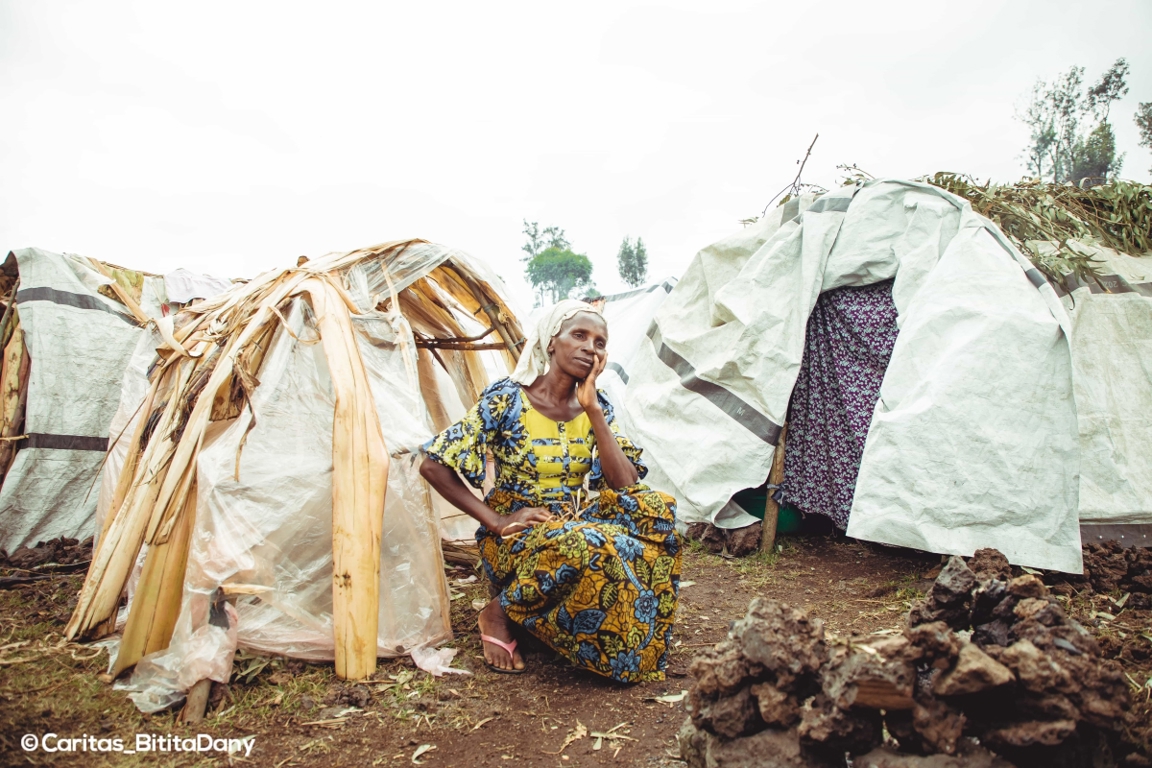Democratic Republic of the Congo
Conflict in the Democratic Republic of the Congo has forced thousands of families to flee their homes. Your support can provide urgent aid to displaced people.

A woman in an IDP camp in Democratic Republic of Congo. Photo: Bitita Dany/Caritas Goma.
The humanitarian crisis in the Democratic Republic of the Congo
25.4 million people
are in need of humanitarian assistance.
6.9 million people
have been forced to flee their homes.
Vulnerable children
are facing malnutrition, exploitation and recruitment as child soldiers.
73% of people
live on less than $USD2.15 per day.
The most urgent needs on the ground at the moment are:
Emergency Tents and Shelter for Displace Families
Access to Clean Water
Health Support for Vulnerable Communities
Food Rations for Families
Democratic Republic of the Congo facing widespread displacement
Communities have been facing ongoing conflict and attacks from armed groups, with near-constant fighting forcing many villagers from their homes. This is a result of protracted crises and conflicts stretching back decades.
-
25.4 million people are in need of humanitarian assistance, including 6.9 million internally displaced peoples (IDPs)
-
Communities are facing repeated attacks on villages, including attacks on civilians, looting and burning of shelters and homes to the ground
- Over 88 per cent of people are staying in overcrowded shelters and improvised sites, with some even sleeping outside
People forced from their homes urgently need medical services, emergency shelter, sleeping supplies, clean water and food.
Our partners are on the ground responding to support communities who require immediate assistance and assessing the most urgent needs.
What is happening in the Democratic Republic of the Congo?
The Democratic Republic of Congo is facing ongoing conflict with a recent escalation of violence between M23 rebels and Congolese troops.
Many communities are facing lack of access to electricity or water.
Hospitals are overwhelmed due to the influx of wounded individuals resulting from the fighting. The Ndosho Hospital has increased its capacity from 147 to 200 beds to manage the emergency, but on the morning of January 23, an additional 120 injured patients were admitted, bringing the total to 250.
Pregnant women, children, and vulnerable elderly people are living in precarious conditions, facing limited access to food, clean water, and essential services. Humanitarian aid is struggling to reach those in need. As fighting escalates, entire families are seeking refuge in churches, schools, and other makeshift shelters in Goma, facing multi-sectoral humanitarian crises.
Local leaders report that more than 200 civilians have been killed in areas captured by the M23 since January 23. In the displaced persons camps on the outskirts of Goma, approximately 180,000 new displaced individuals are reported, adding to the 680,000 displaced already in the camps, thus increasing demographic pressure.
How can I help the Democratic Republic of the Congo?
There are several ways you can help the people of the Democratic Republic of the Congo, including:
- Making a donation to an appeal like Caritas Australia's Africa Conflict, Displacement and Hunger Crisis Appeal.
- Contact your local MP to express your views and ask that Australia does more to help the Democratic Republic of the Congo, and that Australia increases our foreign aid budget.
- Use your voice and speak up about the crisis in contexts and on platforms where you are comfortable doing so.
“While the world is busy and nobody is looking, we have M23 occupying villages forcing people to flee en masse from their homes. We must act quickly, because in one camp there are nearly 20,000 people crammed into one place, without water, sanitation or even shelter. This is a recipe for disaster."

Why are people displaced in Democratic Republic of the Congo?
The near-constant fighting has forced thousands of people from their homes. Ituri and North Kivu provinces have the highest number of displaced people.
Communities are facing repeated attacks on villages, including attacks on civilians, looting and burning of shelters and homes to the ground.
Thousands of people are forced to flee after each attack, seeking safety in schools, churches and outdoor markets. Families have been separated, and many households have lost almost everything to the attacks.
The displaced have nowhere safe to go, and many have been displaced multiple times.
Why are there so many IDP camps in the Democratic Republic of the Congo?
The Democratic Republic of the Congo has over 6.9 million internally displaced peoples (IDPs) and also hosts hundreds of thousands of refugees from other countries.
Due to ongoing crisis, conflict and violence, families are forced to flee their homes every day. The lack of infrastructure and constant threat of violence mean many people have no choice but to gather in overcrowded camps.
What are IDP camps like in the Democratic Republic of the Congo?
Camps are overcrowded and lack access to basic necessities such as clean drinking water, sleeping supplies, hygiene and sanitation, education or protection.
Hear from Lulu Mitshabu, our Program Coordinator for Democratic Republic of Congo, and her extraordinary story of escape from the former dictatorship of Zaire decades ago in Mamamia.

IDP camp near Goma in DRC. Photo: Caritas Goma.
Where does my donation go?
The funds you donate to this appeal go to Caritas Australia’s Emergency Response Fund and will be used to provide humanitarian assistance to communities affected by crises. Should circumstances prevent us from delivering aid to this emergency, or if excess funds remain after the crisis, donations will be directed to other emergencies where Caritas has humanitarian operations.












